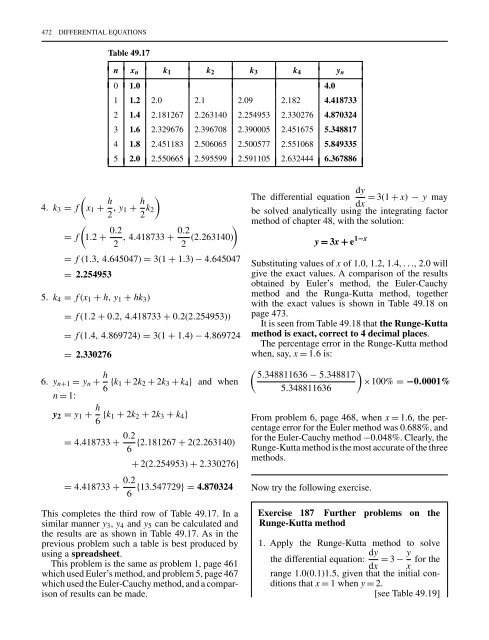differential equation
Create successful ePaper yourself
Turn your PDF publications into a flip-book with our unique Google optimized e-Paper software.
472 DIFFERENTIAL EQUATIONS<br />
Table 49.17<br />
n x n k 1 k 2 k 3 k 4 y n<br />
0 1.0 4.0<br />
1 1.2 2.0 2.1 2.09 2.182 4.418733<br />
2 1.4 2.181267 2.263140 2.254953 2.330276 4.870324<br />
3 1.6 2.329676 2.396708 2.390005 2.451675 5.348817<br />
4 1.8 2.451183 2.506065 2.500577 2.551068 5.849335<br />
5 2.0 2.550665 2.595599 2.591105 2.632444 6.367886<br />
(<br />
4. k 3 = f x 1 + h 2 , y 1 + h )<br />
2 k 2<br />
(<br />
= f 1.2 + 0.2<br />
)<br />
0.2<br />
,4.418733 +<br />
2 2 (2.263140)<br />
= f (1.3, 4.645047) = 3(1 + 1.3) − 4.645047<br />
= 2.254953<br />
5. k 4 = f (x 1 + h, y 1 + hk 3 )<br />
= f (1.2 + 0.2, 4.418733 + 0.2(2.254953))<br />
= f (1.4, 4.869724) = 3(1 + 1.4) − 4.869724<br />
= 2.330276<br />
6. y n+1 = y n + h 6 {k 1 + 2k 2 + 2k 3 + k 4 } and when<br />
n = 1:<br />
y 2 = y 1 + h 6 {k 1 + 2k 2 + 2k 3 + k 4 }<br />
= 4.418733 + 0.2 {2.181267 + 2(2.263140)<br />
6<br />
+ 2(2.254953) + 2.330276}<br />
= 4.418733 + 0.2 {13.547729} =4.870324<br />
6<br />
This completes the third row of Table 49.17. In a<br />
similar manner y 3 , y 4 and y 5 can be calculated and<br />
the results are as shown in Table 49.17. As in the<br />
previous problem such a table is best produced by<br />
using a spreadsheet.<br />
This problem is the same as problem 1, page 461<br />
which used Euler’s method, and problem 5, page 467<br />
which used the Euler-Cauchy method, and a comparison<br />
of results can be made.<br />
The <strong>differential</strong> <strong>equation</strong> dy = 3(1 + x) − y may<br />
dx<br />
be solved analytically using the integrating factor<br />
method of chapter 48, with the solution:<br />
y = 3x + e 1−x<br />
Substituting values of x of 1.0, 1.2, 1.4, ..., 2.0 will<br />
give the exact values. A comparison of the results<br />
obtained by Euler’s method, the Euler-Cauchy<br />
method and the Runga-Kutta method, together<br />
with the exact values is shown in Table 49.18 on<br />
page 473.<br />
It is seen from Table 49.18 that the Runge-Kutta<br />
method is exact, correct to 4 decimal places.<br />
The percentage error in the Runge-Kutta method<br />
when, say, x = 1.6 is:<br />
( )<br />
5.348811636 − 5.348817<br />
×100% = −0.0001%<br />
5.348811636<br />
From problem 6, page 468, when x = 1.6, the percentage<br />
error for the Euler method was 0.688%, and<br />
for the Euler-Cauchy method −0.048%. Clearly, the<br />
Runge-Kutta method is the most accurate of the three<br />
methods.<br />
Now try the following exercise.<br />
Exercise 187 Further problems on the<br />
Runge-Kutta method<br />
1. Apply the Runge-Kutta method to solve<br />
the <strong>differential</strong> <strong>equation</strong>: dy<br />
dx = 3 − y for the<br />
x<br />
range 1.0(0.1)1.5, given that the initial conditions<br />
that x = 1 when y = 2.<br />
[see Table 49.19]










